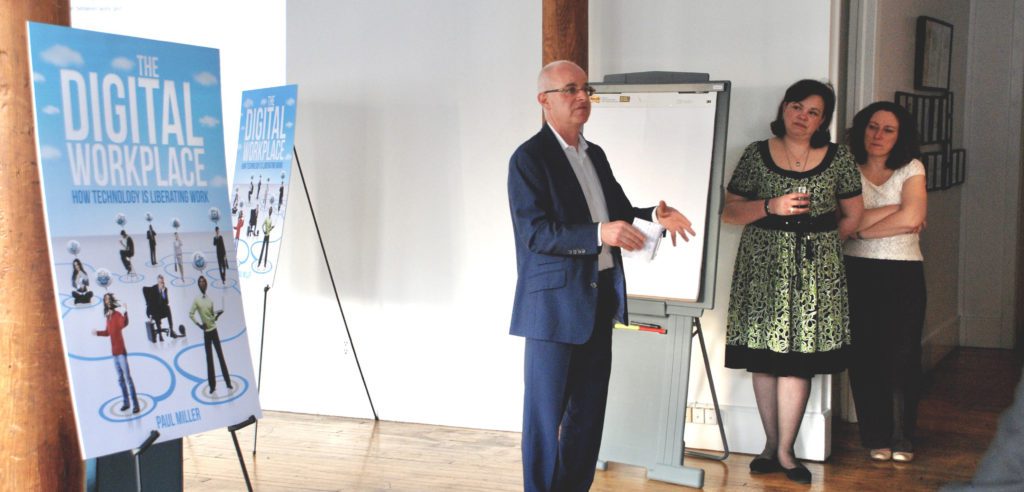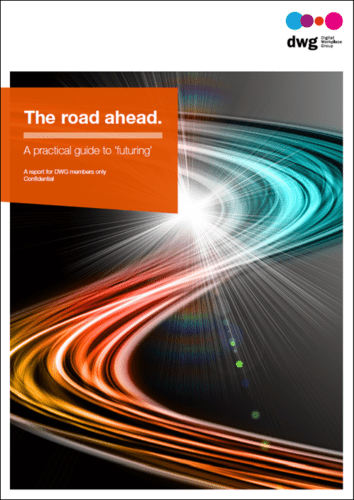Behind the scenes of The Digital Workplace book

Around 2009, people within DWG – then known as the Intranet Benchmarking Forum (IBF) – were beginning to consider the wider suite of digital tools that organizations were introducing alongside their more well-established and better-understood intranets, and to wonder what this combined new array of work practices and products amounted to. Always fascinated by patterns and trends, and how these might evolve in the future, CEO Paul Miller was particularly interested in developing the notion of the ‘digital workplace’, as it was increasingly becoming known within IBF.
Paul’s thesis was that there was a physical world of work but also a digital one – and we were in fact increasingly occupying and working in both spaces at the same time. However, while we had all been familiar since the industrial age with the physical workplace, these new digital spaces (intranets, unified communications, mobile technology and HR systems) were new and evolving at pace.
A creative project that spawned an industry
Paul was in a creative phase and looking for a vehicle to channel this energy. Various ideas had been batted around – some of them too far-fetched, others too mundane to really grab our imagination – but the concept of the emerging, and as yet unnamed and unexplored, ‘digital workplace’ wouldn’t go away.
One day, an impromptu conversation resulted in my suggesting: “I think your creative project should be a book about this digital workplace you keep talking about!”
A few hours later, Paul had mapped out a rough schema for the book. We decided early on that it would not take the form of a standard business book but instead challenge that format. It wouldn’t follow a straightforward narrative but instead present a collection of ideas, examples and lists.
It would look different, too, by introducing typographical features and bite-size sections – something that busy managers within big organizations would find approachable and intriguing to dip into, even if they didn’t have time to read it from cover to cover.
The book would be personal in tone, opening with Paul’s own story of instant work disillusion on Day One of his career (starting out on a highly competitive journalist graduate scheme). He had known immediately from walking into that local newspaper office in the north of England to begin the job he’d worked so hard to secure that the pattern of an office-based job, working for an employer, was not going to be for him. Where was the self-determination? Was there really no freedom of choice over where and how to work? He had hoped work would be a liberating experience – but even a stimulating job like this felt suffocating.
From this start point, Paul was curious to explore whether he was merely a maverick, an outlier, and actually most people were entirely happy with the ‘normal’ work situation of turning up each day for regular hours in a set physical location.
It seemed the majority of people essentially ‘accepted their work lot’ in the absence of any obvious alternatives. Artists might do their own thing, but for the rest, you just understood that you had to work for a certain (large) number of years to sustain yourself and your family, and that this process would invariably involve some degree of drudgery, conformity and routine, with most elements largely outside your own control due to having to be in a certain place involving the same people, hours and work practices each day.
But what if this disappointing experience could be different, with more elements of control and choice? Maybe this was exactly what the new ‘digital workplace’ could bring? People could be liberated from the routine of presenting at a particular desk in a certain building every day.
Viewed from today’s perspective, when HR managers, technology providers, the media, even governments, deliberate continually over how to get the office–home balance right, it seems extraordinary to recall that, just a decade ago, the notion that workplace technology might enable breaking the engrained patterns, allowing people to work from home, or a café, or anywhere they could get a wifi connection, could seem so radical!
But, as the book said, that was how most work was then. Yes, IBM allowed and encouraged remote and what we now call ‘hybrid working’, but this was a rare exception. The idea that work commuting and ‘presenteeism’ were going to change any time soon was met with a deal of scepticism and unease. How could you trust people to do any work when they didn’t have a manager in the room to check up on them? If this workplace revolution was to go anywhere, clearly not just the technology was going to have to evolve but so were attitudes and work practices – and in a dramatic and visionary way.
What does a business book look like?
And it was this need for ‘vision’ that would underpin the structure of the Digital Workplace book. Broadening out from Paul’s own first-day-at-work epiphany, the book was arranged in sections: ‘My World’ (Paul’s own story); ‘Work World’ (considering how things typically were organized and what might have to change); ‘Your World’ (recognizing some of the effects new ways of working could potentially have on people, covering ‘isolation’ and ‘privacy’ etc.); ‘Outside World’ – how different ways of working would impact an organization’s relationships with customers and clients; ‘Digital Worlds’, which looked at how technology can both excite and disappoint, by providing either more or less than expected; ‘Our World’ – how geographical boundaries would become less important as digital technology opened up whole swathes of new global opportunities (for better or for worse); and finally, ‘Future World’ – the most speculative deep dive into where this might all lead in the years and decades to come.
To ground the book (which ran the risk of being dismissed as fanciful), DWG’s very own ‘master of data and research’, Steve Bynghall, was brought in to provide a set of tangible case studies and margin notes that demonstrated real-life examples of companies already implementing some of the ideas and practices being discussed – and generally to sense-check and question some of the more radical proposed content.
An important stage was to commission a designer who would be able to make sense of the complicated structure of the book, with its lists, notes and case studies, bringing together the different elements in a distinctive, yet clear, way. Enter Mark Williams at Toast Design in Banbury, England and the start of a wonderful working relationship.
This connection has led to Mark’s involvement in almost all DWG’s brand design since, across all its output, including two further books, The Digital Renaissance of Work: Delivering digital workplaces fit for the future, co-authored with DWG Research Director, Elizabeth Marsh, and published in 2016, and more recently the beautifully illustrated and produced Nature of Work: The new story of work for a living age.
Digital Renaissance of Work developed many of the themes that had been kicked off in Digital Workplace, offering practical tips on how to apply digital working practices within companies. Nature of Work, co-authored with DWG Director of Knowledge, Shimrit Janes, is a more visionary look at how organizations can adapt to reflect growing cultural awareness of the importance of diversity, inclusion and environmental responsibility, and how to organize work in a forever-changed post-pandemic world.
Going the self-publishing route
We also wanted to ensure that Digital Workplace was not dumbed down by the standard editorial process. So, early on, the decision was taken to go down the self-publishing route, also a relatively new thing at the time, with not nearly as many options as today. Commissioning a local printer to produce 2,000 hardback books (quickly reprinted) was the easy bit; getting it onto Amazon as a paperback and Kindle version much harder! With these kinds of service in their infancy, it proved very difficult to reproduce the complicated design of the book through the simplistic self-publishing outfits on offer, as they all required the text to be linear in layout. After much research and negotiation, this was achieved, but it was a struggle to say the least.
When, after a brief foray with a publisher for the Digital Renaissance book (which did result in exactly the kind of lack of control we had feared), we returned to the self-publishing model for Nature of Work, it was a relief to find that by 2020 there were so many more options that it is now possible (and comparatively straightforward) to produce, publish and distribute exactly the kind of book you envisage, retaining complete control over all aspects of the finished product.
Ten years on from the publication of Digital Workplace, there is now, according to Gartner, a $30 billion a year industry centred on digital working. And when the entirely unforeseen global pandemic arrived, we discovered that not only was the digital workplace mostly ready and able to cope, it had become the ‘essential workplace’. Habits and patterns of office working evaporated overnight and a new era of hybrid working is now the norm.
We can only wonder, at this stage, whether Nature of Work and the underlying concept that companies are alive – more akin to organisms than organizations; not machines but living systems – will prove to have tapped into an equally seismic transformation of work a decade or so from now.
Categorised in: 20 Perspectives from 20 Years series, Digital workplace, Working at DWG
